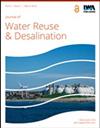确定两种工业废水急性生物毒性影响因素的优先顺序
IF 2.3
Q2 Environmental Science
引用次数: 1
摘要
识别主要导致废水急性毒性的关键参数或成分将有助于快速方便地反映其生物毒性。在本研究中,分析了从两个生产魔芋和玻璃的工厂收集的64个出水样品的成分/参数和生物毒性。研究发现,这两种类型的废水没有得到内部技术的有效处理。此外,通过对费氏弧菌的生物发光抑制评估的急性生物毒性显示,约90%的流出物被标记为有毒,生物发光抑制率高于50%。通过应用灰色关联分析(GRA)方法研究出水特性对生物毒性的影响优先级,结果表明,对生物发光抑制作用影响最大的四个因素是:TN≈SO42−>Cl−>as≈Hg(魔芋生产废水)和Zn>SO42−≈TN>as>Cl−(玻璃生产废水)。这些结果将有助于通过评估最具影响的参数来快速识别工业废水的生物毒性特征,并有助于降低生物急性毒性,保护下游污水处理厂免受突然坍塌的影响。本文章由计算机程序翻译,如有差异,请以英文原文为准。
Identifying influential priority of factors governing the acute biological toxicity of two kinds of industrial wastewaters
Identifying the key parameters or components mainly contributing to the acute toxicity of wastewater would be helpful to quickly and conveniently reflect their biological toxicity. In this study, the components/parameters and biological toxicity of 64 effluent samples collected from two factories producing konjac and glass were analyzed. It was found that the two types of wastewaters were not effectively dealt with the inner technology. Moreover, the acute biological toxicity evaluated by the bioluminescence inhibition to Vibrio fischeri revealed that ∼90% of the effluents were marked as toxic with bioluminescence inhibition higher than 50%. By applying a grey relational analysis (GRA) method to investigate the influential priorities of the effluent characteristics on biological toxicity, the results demonstrated that the top four influential factors on the bioluminescence inhibition were as follows: TN ≈ SO42− > Cl− > As ≈ Hg (for konjac-manufacturing effluents) and Zn > SO42− ≈ TN > As > Cl− (for glass-producing effluents). These results would be useful for fast recognizing the biological toxicity features of industrial effluents via evaluating the most influential parameters, and helpful for reducing the biological acute toxicity to protect the downstream wastewater treatment plant from abrupt collapse.
求助全文
通过发布文献求助,成功后即可免费获取论文全文。
去求助
来源期刊

Journal of Water Reuse and Desalination
ENGINEERING, ENVIRONMENTAL-WATER RESOURCES
CiteScore
4.30
自引率
0.00%
发文量
23
审稿时长
16 weeks
期刊介绍:
Journal of Water Reuse and Desalination publishes refereed review articles, theoretical and experimental research papers, new findings and issues of unplanned and planned reuse. The journal welcomes contributions from developing and developed countries.
 求助内容:
求助内容: 应助结果提醒方式:
应助结果提醒方式:


